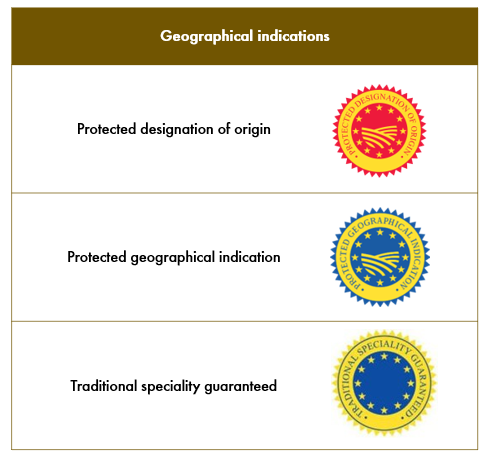Changes in the EU system for protection of geographical indications
So far, geographical indications have been primarily relevant to just a few countries, such as Italy and France. But recent changes at the EU level are opening up interesting prospects for Polish producers as well. Below we write more about what geographical indications are, how the protection system has recently changed, and who stands to benefit from these changes.
Conceptual map
The system for protection geographical indications uses a complex conceptual grid. The scheme employs a number of similar-sounding names, and their subject matter can also overlap.
The basic concepts can be ranked in terms of the number of criteria that must be met during production, making it much easier to distinguish between these categories.

The protected designation of origin (PDO) is the most restrictive designation for a product:
- Originating in a specific place, region or (in exceptional cases) country
- Whose quality or characteristics are essentially or exclusively due to a particular geographical environment with its inherent natural and human factors, and
- The production steps of which all take place in the defined geographical area.
This category protects foodstuffs such as the Italian cheese Grana Padano, the Polish cheese oscypek, and flavoured wines such as vermouth, sangria and Glühwein.
The protected geographical indication (PGI) is for a product:
- Originating in a specific place, region or country
- Whose given quality, reputation or other characteristic is essentially attributable to its geographical origin, and
- At least one of the production steps of which take place in the defined geographical area.
Foods such as the Kraków bagel (obwarzanek krakowski) are entitled to such protection, as well as aromatised wines.
The similar-sounding geographical indication is a separate category in the system protecting the name of a spirit drink (minimum 15% alcohol) originating from a place, area or country where a particular quality, reputation or other characteristic of the product is generally attributed to its geographical origin. Legal names under which products are marketed are also associated with spirit drinks. For example, “Scotch whisky” would be a geographical designation, while the legal name for the product would be “whisky.” The use of geographical indications is much more restrictive than for legal names.
A slightly different category is the traditional speciality guaranteed (TSG). This term emphasises traditional aspects, such as how a product is made or its composition, without being linked to a specific geographic area. As with protected designations of origin and geographical indications, the registration of a product as a TSG protects against counterfeiting and misuse. This category includes, for example, Mozzarella Tradizionale cheese and Kraków sausage (kiełbasa krakowska sucha staropolska).
The scheme also includes optional quality terms, which protect, for example, products from mountain areas. Producers can apply them to label their products voluntarily, to spread information about the added value of their products made under certain conditions or in a certain area. But the quality term must relate to a characteristic of one or more categories of products, or an attribute of farming or processing that applies in specific areas.
In addition to the individual categories within the EU system, lawmakers also use “geographical indication” as a collective term for all categories.
The previous legal framework
So far, the system for protecting products originating in a specific region, or associated with unique characteristics or reputation due to their geographic origin, has covered only agricultural products and foodstuffs (including, according to the EU definition, spirit drinks and wines). Any craft or industrial products, which certain geographic regions are also often famous for, remained outside the EU system. Depending on the law applicable in a given member state, they might have been entitled to protection, but only at the national level.
The EU system was based on four main pillars, with separate regulations for:
- Agricultural products and foodstuffs
- Wines
- Spirit drinks
- International geographical indications.[1]
In Poland, geographical indications were protected not only pursuant to the EU regulations, but also under the Industrial Property Act and the Unfair Competition Act, while the national stage of the registration was governed by the Act on Registration and Protection of Designations of Origin, Geographical Indications, and Traditional Specialities Guaranteed of Agricultural Products and Foodstuffs, Wines or Spirit Drinks and Traditional Products of 9 March 2023.
As signalled at the EU level for many years, the lack of uniform rules and the fragmentation of regulations into several legal acts have not been conducive to effective protection of products and the geographical indications used for them. The new provisions were designed to strengthen this protection and support producers of goods eligible for protection.
In principle, the scope of protection provided by the new unified system under the new Regulation (EU) 2024/1143 of the European Parliament and of the Council of 11 April 2024 on geographical indications for wine, spirit drinks and agricultural products, as well as traditional specialities guaranteed and optional quality terms for agricultural products, is no different from the existing provisions, and continues to provide protection against:
- Direct or indirect commercial use of the geographical indication in respect of products not covered by the registration, including where the use of the name exploits, weakens, or dilutes the reputation of the protected name
- Any misuse, imitation or evocation, even if the use of the indication is accompanied by terms such as “style,” “type,” or “flavour”—recital 35 to Regulation 2024/1143 explains that “evocation” may arise “where a link with the product designated by the registered geographical indication, including with reference to a term, sign, or other labelling or packaging device, is present in the mind of the average European consumer who is reasonably well-informed, observant and circumspect”
- Any other false or misleading indication as to the provenance, origin, nature or essential qualities of the product, used on the inner or outer packaging, advertising materials or websites.
The most important changes
- As of 13 May 2024, unified rules for registration and protection of geographical indications for agricultural products and alcoholic beverages are in force. Where they were previously covered by three separate regulations, now they are governed by one EU act: Regulation 2024/1143. Under the new provisions, the registration time has been reduced to six months.
- The system for protection of geographical indications covers not only agricultural products, foodstuffs, wine and spirit drinks, but also craft and industrial products. This is a completely new aspect of the system, which extends to businesses that have been creating traditional local products for years. These rules are set out in the new Regulation (EU) 2023/2411 of the European Parliament and of the Council of 18 October 2023 on the protection of geographical indications for craft and industrial products, which will begin to apply in December 2025.
- A new feature is the protection of geographical indications in internet domain names, which allows member states to block domain names potentially infringing on indications and to give consideration to indications in resolving domain disputes. The EUIPO is working on an information and alert system that will help applicants assess the availability of geographical indications as domain names and optionally register them.
- The new provisions have strengthened the importance of producer groups. They have been granted a number of powers that will significantly increase the effectiveness of the protection of the geographical indications of their products.
Each of these changes has important implications for the operation of the geographical indication protection system. In subsequent articles, we will discuss them in detail.
Conclusion
The latest changes should be viewed positively, as they guarantee a unified system that will improve law enforcement mechanisms, enable producers to effectively protect their products from misuse and imitation, and ensure consumers access to quality, authentic products. The reform also shows producers that it is worthwhile to cooperate through organisations to protect the designations they use and the products covered by these designations, facilitating protection of their interests and ensuring a competitive market.
Enhanced protection of geographical indications also helps each member state to protect its cultural heritage, and local traditions, knowledge and production methods—a particularly pressing issue in the age of globalisation.
Katarzyna Sotyn, attorney-at-law, Intellectual Property practice, Wardyński & Partners
[1] The most relevant acts governing the protection of designations have been:
- Regulation (EU) No 1151/2012 of the European Parliament and of the Council of 21 November December 2012 on quality schemes for agricultural products and foodstuffs
- Regulation (EU) No 1308/2013 of the European Parliament and of the Council of 17 December 2013 establishing a common organisation of the markets in agricultural products
- Regulation (EU) 2019/787 of the European Parliament and of the Council of 17 April 2019 on the definition, description, presentation and labelling of spirit drinks, the use of the names of spirit drinks in the presentation and labelling of other foodstuffs, the protection of geographical indications for spirit drinks, the use of ethyl alcohol and distillates of agricultural origin in alcoholic beverages
- Regulation (EU) 2019/1753 of the European Parliament and of the Council of 23 October 2019 on the action of the Union following its accession to the Geneva Act of the Lisbon Agreement on Appellations of Origin and Geographical Indications.
